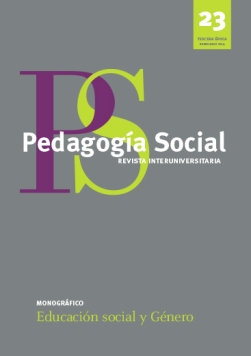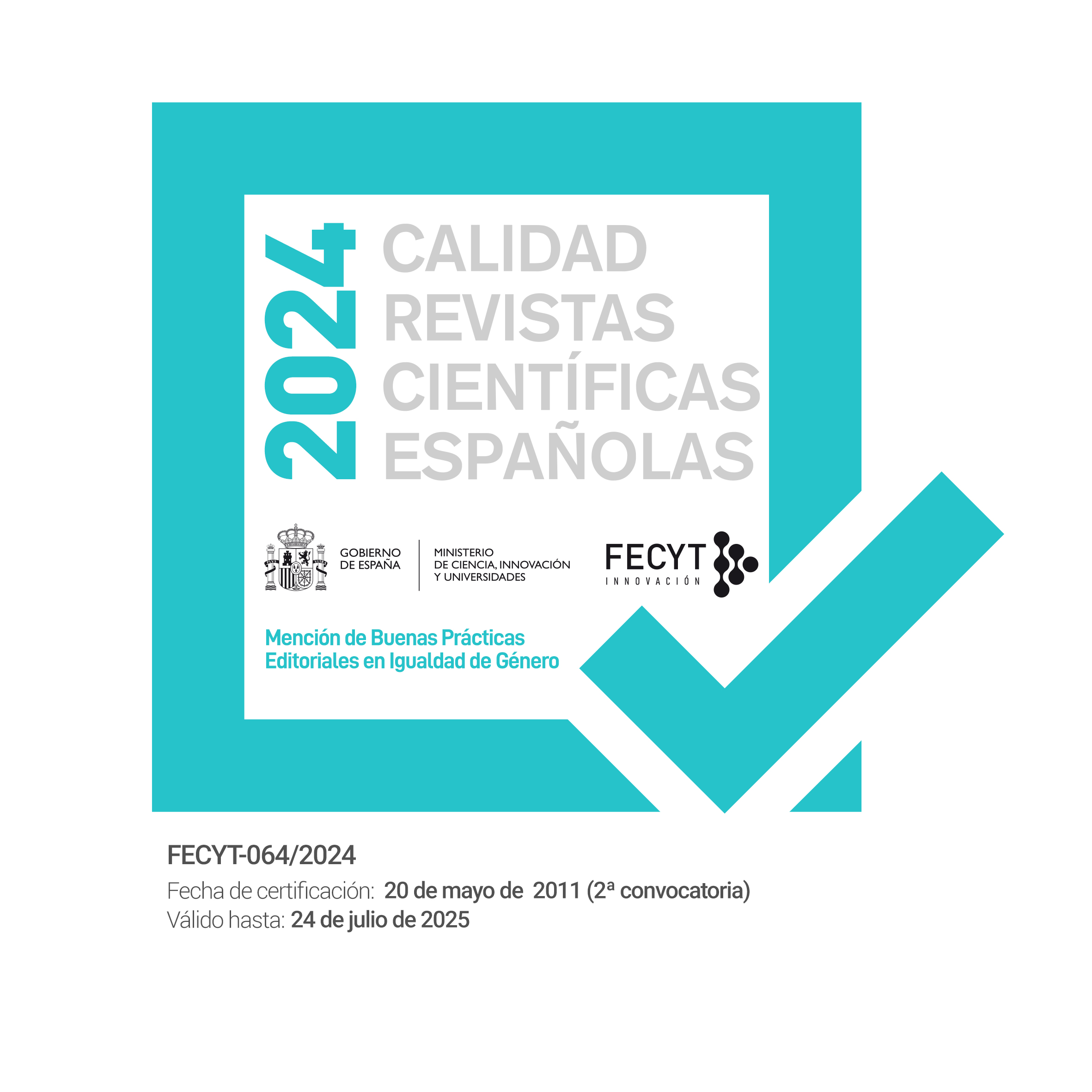SOBREVIVÊNCIA E TRANSCENDÊNCIA TRANSNACIONAL IMIGRANTES LATINA INDIFENOUS (ILIS) NOS EUA
DOI:
https://doi.org/10.7179/PSRI_2014.23.02Palavras-chave:
Transnacional, Indígena, Latina Imigrante, Survival, Imigração, EducaçãoResumo
Transnacionais imigrantes latinos indígenas hoje parecem viver várias vidas em várias fronteiras.
Combase emumestudo de pesquisamétodosMix de 3 anos que teve lugar naCarolina do Norte,
o manuscrito descreve as experiências de imigrantes Latina Indígenas (Ilis) que vivem nos Estados Unidos,
especificamente pedagogias de sobrevivência com base em identidades sociais fluidas. As mulheres
indígenas que participaram neste estudo tiveram que adotar fluidas identidades desconhecidas,
tanto em casa para a sobrevivência cultural, e também fora de casa (identidades externas) para a sobrevivência
física e social, muitas vezes em ambientes hostis. Além disso, levanta questões sobre como
omultilinguismo afeta mobilidade e transnacionalidade fronteira, bem como a forma como indígena Latina
imigrantes se Camaleonas guerreras (guerreiros Chameleon) que usam "ferramentas essenciais
de sobrevivência", como uma ponte transnacional para facilitar a sua sobrevivência em um ambiente
hostil dos EUA, o comunidade e nas escolas.
Downloads
Referências
Anderson,W. (1997). Familias purépechas en el sur de Illinois: La (re)construcción de la identidad étnica. Paper presented at the XIX Coloquio de Antropología e Historia Regionales, El Colegio deMichoacán, Ciudad de Zamora.
Anzaldua, G. (1987). Borderlands/la frontera: The new mestiza. San Francisco, CA: Aunt Lute Books.
Aranda, E.M. (2006). Emotional bridges to Puerto Rico:Migration, returnmigration, and the struggles of incorporation.New York, NY: Rowman & Littlefield.
Basch, L., Schiller, N. and Szanton Blanc, C. (1994). Nations unbound: Transnational projects, postcolonial predicaments and deterritorialized nation-states. Amsterdam: Gordon & Breach.
Clandinin, D. J., &Connelly, F.M. (2000). Narrative inquiry: Experience and story in qualitative research. San Francisco,CA: Jossey-Bass.
Creswell J. (1998). Qualitative inquiry and research design: Choosing among five traditions. Thousand Oaks, CA: Sage Publications.
Delgado-Gaitan, C. (1990). Literacy for empowerment: The role of parents in children’s education. Bristol: The Falmer Press.
Durand, J., &Massey, D. S. (2004).What we learned fromtheMexicanmigration project. In J. Durand, & D. S.Massey (Eds.), Crossing the border: Research from theMexican migration project (pp. 1-16). Berkeley, CA: University of California Press.
Flores, N., Hernández León, R., & Massey, D. R. (2004). Social capital and emigration from rural and urban communities. In J. Durand, & D. S. Massey (Eds.), Crossing the border: Research from the Mexican migration project (pp. 184-200). New York, NY: Russell Sage Foundation.
Fox, J. (2006). ReframingMexican migration as a multi-ethnic process. Latino Studies, (4), 39-61.
Fox, J., & Rivera-Salgado, G. (Eds.) (2004). IndigenousMexicanmigrants in the United States. La Jolla, CA: University of California, San Diego, Center for Comparative Immigration Studies and Center for US–Mexican Studies.
Gibson,M., Gandara, P., & Koyama, J. (2004). School connections: U.S.Mexican youth, peers, and school achievement. New York, NY: Teachers College Press.
Glick Schiller, N., Basch, L., & Szanton-Blank, C. (1992). Transnationalism: A new analytic framework for understanding migration. In N. Glick Schiller, L. Basch, & C. Szanton-Blank, (Eds.), Toward a transnational perspective on migration (pp. 1-24). New York, NY: New York Academy of Sciences.
González, N. (2001). I am my language: Discourses of women and children in the borderlands. Tucson, AZ: The University of Arizona Press.
Guerra, J. C. (1998). Close to home:Oral and literate practices in a transnationalMexicano community. New York, NY: Teachers College Press.
Machado-Casas, M. (2006). Narrating education of new Indigenous/Latino transnational communities in the South. Unpublished dissertation. Chapel Hill, NC: University of North Carolina at Chapel Hill.
Machado-Casas, M. (2009a). La supervivencia transnacional de inmigrantes indígenas en Estados Unidos por medio de la tecnología informártica. DIDAC, 54, 13-23.
Machado-Casas,M. (2009b). The politics of organic phylogeny: The art of parenting and surviving as transnational multilingual Latino Indigenous immigrants in the U.S. High School Journal, 92(4), 82-99.
Machado-Casas,M. (2010). The newglobal transnational citizen: The role ofmultilingualismin the lives of Latino/s indigenous immigrants in the U.S. CIMEXUS: Revista de InvestigacionesMéxico Estados Unidos, 2(7), 99-123.
Machado-Casas,M. (2010). Puppet Pedagogies: Indigenous Latino Immigrant’s and Public School in theUS. Unpublishedmanuscript.
Massey,D. S. (1999). Internationalmigration at the dawn of the twenty-first century: The role of the state. Population andDevelopment Review, 25(2), 303-323.
Merriam, S.B. (1998).Qualitative research and case study:Applications in education. San Francisco,CA: Jossey-Bass Publishers.
Nieto, S. (2004). Affirming diversity: The sociopolitical context of multicultural education (6th Ed.). New York: Pearson Education.
Ong, A., &Nonini,D. (Eds.) (1997). Ungrounded empires: The cultural politics ofmodernChinese transnationalism.NewYork, NY: Routledge Publishers.
Passel, J. S. & Suro, R. (2005). Rise, Peak, and Decline: Trends in U.S. Immigration 1992–2004. September.Washington DC: Pew Hispanic Center.
Portes, A., & Rumbaut, R. G. (2001). Legacies: The store of the immigrant second generation. New York, NY: Russell Sage Foundation.
Rivera-Salgado, G. (1999).Migration and political activism:Mexican transnational Indigenous communities in a comparative perspective. Ph.D. Dissertation. Santa Cruz, CA: University of California, Santa Cruz.
Sánchez, P. & Machado-Casas, M. (2009). Introduction: At the intersection of transnationalism, Latina/o Immigrants, and education. High School Journal, 92(4), 3-15.
Schiller,N., Basch, L., & Szanton-Blanc,C. (1992). Transnationalism: ANewAnalytic Framework forUnderstandingMigration’. Toward a Transnational Perspective on Migration. N. Glick Schiller, Basch, L., & Szanton-Blank, C. (eds). New York, New York Academy of Sciences: 1-24.
Stephen, L. (2007). Transborder lives: IndigenousOaxacans inMexico, California, andOregon. Durham, NC: Duke University Press.
Trueba, E. (2004). The new Americans: Immigrants and transnationals at work. New York, NY: Rowman & Littlefield Publishers Inc.
Urrieta, L., Jr. (2009). Fighting fromwithin!Chicana andChicano educators inU.S. schools. Tucson,AZ:University of Arizona Press
Valdés, G. (1996). Con respeto. Bridging the distance between culturally diverse families and schools. New York, NY: Teachers College Press.
Vasquez,O.A., Pease-Alvarez, P.,&Shannon, S.M. (1994). Pushing boundaries: Language and culture in aMexicano community. New York, NY: Cambridge University Press.
Vertovec, S. (1999). Conceiving and researching transnationalism. Ethnic and Racial Studies, 22(2).
Zabin, C., Kearney, M., Garcias, A., Runsten, D., & Nagengast, C. (1993). Mixtec migrants in California agriculture: A new cycle of poverty. Davis, CA: California Institute for Rural Studies.
Zentella, A. C. (1997). Growing up bilingual: Puerto Rican children in New York. Malden,MA: Blackwell Publishers.
Downloads
Ficheiros Adicionais
Publicado
Como Citar
Edição
Secção
Licença
Direitos de Autor (c) 2014 Pedagogia Social. Revista Interuniversitaria

Este trabalho encontra-se publicado com a Licença Internacional Creative Commons Atribuição-NãoComercial 3.0.
Derechos de reproducción y archivo
La versión publicada de los artículos podrá ser autoarchivada por sus autores en repositorios institucionales y temáticos de acceso abierto. No obstante la reutilización total o parcial de los mismos en nuevos trabajos o publicaciones deberá ser autorizada por Pedagogía Social. Revista Interuniversitaria.
Los trabajos publicados deberán ser citados incluyendo el título de la Revista, Pedagogía Social. Revista Interuniversitaria, nº, páginas y año de publicación.
Responsabilidades éticas
Pedagogía Social. Revista Interuniversitaria no acepta material publicado anteriormente en otros documentos. Los/as autores/as son responsables de obtener los permisos oportunos para reproducir parcialmente material de otras publicaciones y citar correctamente su procedencia. Estos permisos deben solicitarse tanto al autor/a como a la editorial que ha publicado dicho material.
Es obligación de Pedagogía Social. Revista Interuniversitaria detectar y denunciar prácticas fraudulentas.
En la lista de autores/as firmantes deben figurar únicamente aquellas personas que han contribuido intelectualmente al desarrollo del trabajo.
La revista espera que los/as autores/as declaren cualquier asociación comercial que pueda suponer un conflicto de intereses en conexión con el artículo remitido.
Los autores deben mencionar en el manuscrito, preferentemente en el apartado del método, que los procedimientos utilizados en los muestreos y controles han sido realizados tras la obtención de consentimiento informado.
La revista no utilizará ninguno de los trabajos recibidos con otro fin que no sea el de los objetivos descritos en estas normas.
Aviso de derechos de autor/a
© Pedagogía Social. Revista Interuniversitaria. Los originales publicados en las ediciones impresa y electrónica de esta Revista son propiedad del Pedagogía Social. Revista Interuniversitaria, siendo necesario citar la procedencia en cualquier reproducción parcial o total.
Salvo indicación contraria, todos los contenidos de la edición electrónica se distribuyen bajo una licencia de uso y distribución “Creative Commons Reconocimiento-No Comercial 3.0 España” (CC-by-nc). Puede consultar desde aquí la versión informativa y el texto legal de la licencia. Esta circunstancia ha de hacerse constar expresamente de esta forma cuando sea necesario.






